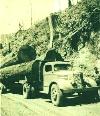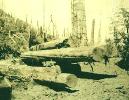


|

|

|
Although Railroads predominated as a means of logging transportation in the first half of the 20th century, it occurred to loggers that trucks could haul logs too, and improved trucks quickly displaced the railroads after World War II. Typical of the post war truck is this White truck shown working in Tillamook County doing salvage logging after the Tillamook Burn.
If the load on this truck looks like a bit much for the truck, it is because it was. The truck was a single axle tractor with a single axle trailer. These days log trucks universally have multiple axles to help support the weight. Often times, as the railroads were on the way out but not gone yet, trucks would be used to haul the logs to a reload point where the logs would be transferred to a logging train for the final ride to the mill. this permitted the existing trackage to be used, but avoided the necessity of building expensive new trackage.
As you can see from looking at this truck, the stinger steered log trailer was used in the Pacific Northwest from the beginning. The logs are actually the frame of the trailer. That which looks like a tongue of the trailer is actually a 'reach'. In the days of this truck it was surely wooden, but in newers trucks is surely steel. It is not used to 'pull' the trailer. Indeed, it is set up with a slip joint as it must change length as the truck turns. Both the log bunk on the truck and the one on the trailer are on pivots, and the job of the reach is to keep the trailer axles aligned behind the truck. It also turns out, that if the hitch point on the truck (the stinger) is extended considerably behind the rear axle of the truck, the trailer will track the truck better. This is because as you steer the front of the truck to say the right, the truck will pivot on the rear axle and the rear of the truck will swing to the left. This in turn swings the reach to the left which steers the trailer to the left, discouraging the trailer from cutting the corner. Configured aggressively (with the distance from the trck axle to the hitch equal to the distance from the hitch to the trailer axle) the trailer wheels will track exactly behind the rear truck wheels, no matter how short a turn you make. Compare this to the 'semi-trucks' which you find on your local street corner.
For more on logging history, see the logging history page, and for more on trucks see the truck page.
A special thanks to Bob Sharp for photos on this page.